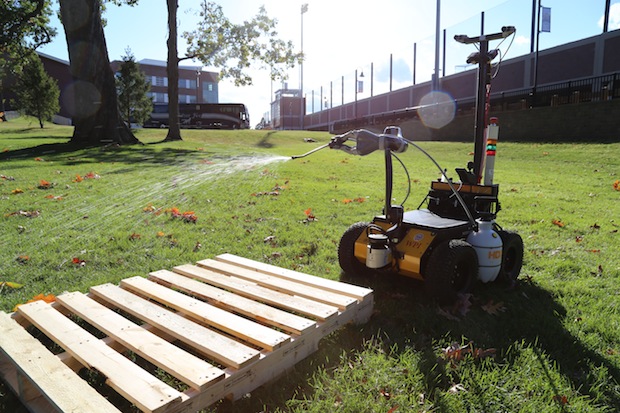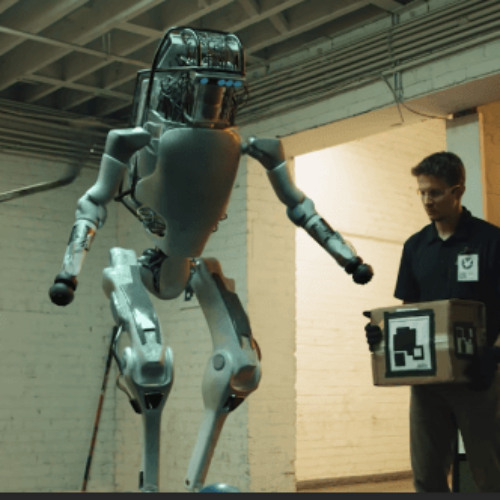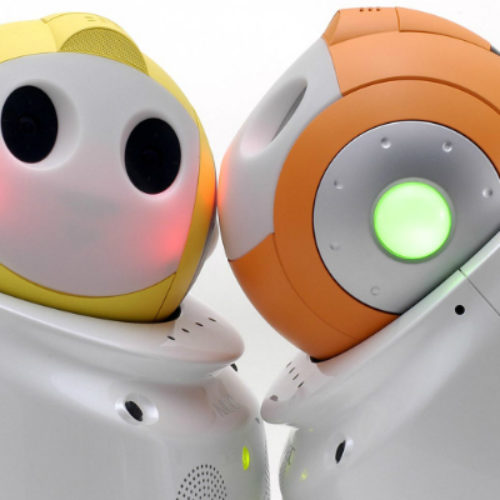Real Robots to Help Fight Ebola
A few Fridays ago, we took a little bit of a dig at all of the media coverage of an “ebola-fighting robot” that turned out to be essentially just a UV light on a wheeled cart hooked up to a timer. It’s clever marketing, but not clever robotics. Even one of the fanciest UV disenfecting “robots” have instructions that begin, “after a hospital staff member cleans the room using traditional methods…” This is not what real robots are all about. Real robots use autonomy (or at least teleoperation) to keep humans as far away from dangerous situations as possible.

Photo: WPI
You’d think that real robots would have a lot to offer when it comes to assisting with the control of a highly infectious disease, just like you’d think that robots would have a lot to offer when it comes to assisting with the control of a highly radioactive nuclear power plant. You’d be right to think that, but the problem that we’re having now with Ebola is the same as the problem that we had with Fukushima: there simply aren’t any robots that are prepared and ready, right now, to tackle an immediate crisis, even though robots would be immensely valuable in this situation.
To attempt to rectify this, the Center for Robot-Assisted Search and Rescue (CRASAR) at Texas A&M University is partnering with the White House Office of Science and Technology and other groups to hold a policy workshop on Safety Robotics for Ebola Workers. The goal of the workshop will be to not just figure out what kinds of robots would be valuable to have on-hand for future epidemics, but also to try and identify things that the robots we havenow can actually help with. And they’ve already got some good ideas.
In a recent blog post, CRASAR director Robin Murphy list some possibilities that her team has come up with in their discussions:
- Mortuary robots to respectfully transport the deceased, as ebola is most virulent at the time of death and immediately following death
- Reducing the number of health professionals within the biosafety labs and field hospitals (e.g., automated materials handling, tele robotics patient care)
- Detection of contamination (e.g., does this hospital room, ambulance or house have ebola)
- Disinfection (e.g., robots that can open the drawers and doors for the commercially available “little Moe” disinfectant robot)
- Telepresence robots for experts to consult/advise on medical issues, train and supervise worker decontamination to catch accidental self-contamination, and serve as “rolling interpreters” for the different languages and dialects
- Physical security for the workers (e.g., the food riots in Sierre Leone)
- Waste handling (e.g., where are all the biowaste from patients and worker suits going and how is it getting there?)
- Humanitarian relief (e.g., autonomous food trucks, UAVs that can drop off food, water, medicine, but also “regular” medicine for diabetes, etc., for people who are healthy but cut off)
- Reconnaissance (e.g., what’s happening in this village? Any signs of illness? Are people fleeing?)
She also explains some of the challenges:
“In order to be successful at any one of the tasks, robots have to meet a lot of hidden requirements and sometimes the least exciting or glamorous job can be of the most help to the workers. Example hidden requirements: Can an isolated field hospital handle a heavy robot in the muddy rainy season? How will the robots be transported there? Is it easy enough for the locals to use so that they can be engaged and earn a living wage? What kind of network communication is available? What if it needs repairs? That’s what I am working on, applying the lessons learned in robotics for meteorological and geological disasters.”
Some of these tasks would be achievable with existing systems, or with relatively minor modifications to existing systems, assuming that the infrastructure requirements are met. For example, telepresence robots would allow Ebola experts anywhere in the world to consult with patients (and with local doctors) while undertaking zero risk, and at low expense and a much more reasonable investment of time.
The picture at the top of this article is a more specific example: it’s a Huskythat’s been outfitted with an arm and a spray system that can decontaminate anything you (remotely) point it at. Taskin Padir, a professor at Worcester Polytechnic Institute who put this system together, explained to Computerworld why hacking something together like this is the only way to go in the short term:
“We are not trying to come up with a brand new design because I don’t think we have time for that,” Padir said. “I’m trying to repurpose some of the standard designs we have. We want to be able to deploy something within three months. I can’t design brand new robots that would take a year to figure out.”
Another idea includes using a remotely operated Bobcat to somehow respectfully manage and bury deceased Ebola victims. But this is where you have to consider all kinds of non-technical issues, which is why CRASAR is holding this workshop in the first place. You can’t just make a robot that will functionally deal with burying people—you have to make one that does so in a way that’s culturally appropriate, and to figure out how to do that, you need to talk to the people who are going to be using this robot, and establish guidelines for use in a wider social context.
This seems like a very sensible and considerate approach to deploying robots to help fight ebola. And realistically, it’s about as fast as we could possibly expect to get any sort of robotic system from not existing to doing something practical out in the field. Even so, we have to wonder what the Ebola epidemic will be like three months from now, and how much of a difference it would have made to have robots ready for something like this earlier.
Source: www.spectrum.ieee.org/
You might also like
A Parody of Boston Dynamics Robots Fighting Back
Anyone with the slightest interest in robots will have watched a Boston Dynamics video at some point. Each time Atlas, Spot, or one of the robots is further developed they
The Updated Handle From Boston Dynamics
Back in 2017, Boston Dynamics unveiled the first version of Handle. Although it had legs with what looked like knees bent backward, it also had wheels for its feet. The
PaPeRo
PaPeRo – the Partner-type Personal Robot – was created as a beginning to a robot assisted future envisioned by NEC to help humans live “life with more time to spare.”



